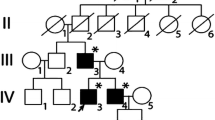Summary
Psychiatric manifestations of familial spastic paraplegia are rare and have been described only infrequently. A 35-year-old male is reported, who presented both hypomanic behaviour and gait disturbances as features of a previously undiagnosed familial spastic paraplegia. This association implies that the CNS manifestations of familial spastic paraplegia may overlap with the neurochemical or neuroanatomic substrata regulating mood.
Similar content being viewed by others
References
Bickerstaff ER (1950) Hereditary spastic paraplegia. J Neurol Neurosurg Psychiatr 13:134–145
Bodechtel G (1984) Degenerativ-atrophisierende Erkrankungen. In: Bernsmeier A, Schrader A, Struppler A (eds) Differentialdiagnose neurologischer Krankheitsbilder, 4th edn. Thieme, Stuttgart, pp 7–8
Brown J, Coleman R (1966) Hereditary spastic paraplegia with ocular and extra-pyramidal signs. Bull Los Angeles Neurol Soc 31:21–34
Danadoost DM, Jackson CE, Teasdall RD (1977) The clinical variations of hereditary spastic paraplegia in four families. Henry Ford Hosp Med 25:3–12
Ferguson F, Critchley M (1929) A clinical study of an heredo-familial disease resembling disseminated sclerosis. Brain 52:203–225
Lishman WA (1980) Organic psychiatry; The psychological consequences of cerebral disorder. Blackwell, Oxford, p 870
Mahloudji M (1963) Hereditary spastic paraplegia simulating disseminated sclerosis. J Neurol Neurosurg Psychiatr 26:511–513
Ozsvath K (1968) Paralysis spinalis spastica infantilis. Dtsch Z Nervenheilk 193:287–323
Rothner AD, Yahr F, Yahr MD (1976) Familial spastic paraparesis, optic atrophy and dementia. NY State J Med 76:756–758
Seeligmuller A (1876) Sklerose der Seitenstrange des Rückenmarks bei vier Kindern der selben Familie. Dtsch Med Wochenschr 2:185–186
Strümpell A (1880) Beiträge zur Pathologie des Rücken-muskels. Arch Psychiatr Nervenkr 10:676–717
Sutherland JM (1957) Familial spastic paraplegia, its relation to mental and cardiac abnormalities. Lancet 1:169–170
Sutherland JM (1975) Familial spastic paraplegia. In: Vincken PJ, Bruyn GW (eds) Handbook of clinical neurology, vol 22. System disorders and atrophies, part II. North Holland Publ Co, Amsterdam, pp 421–431
Author information
Authors and Affiliations
Rights and permissions
About this article
Cite this article
Jansen, P.H.P., Keyser, A. & Raes, B.C.M. Hypomanic behaviour associated with familial spastic paraplegia. Eur Arch Psychiatr Neurol Sci 238, 28–30 (1988). https://doi.org/10.1007/BF00381076
Received:
Issue Date:
DOI: https://doi.org/10.1007/BF00381076




